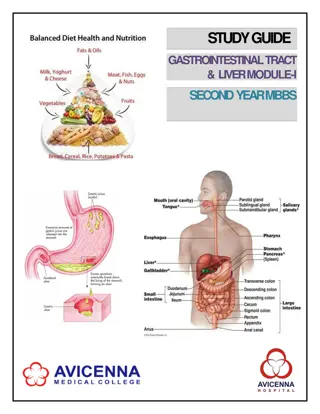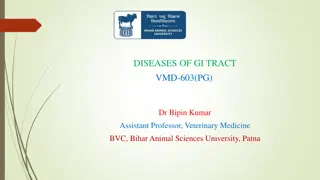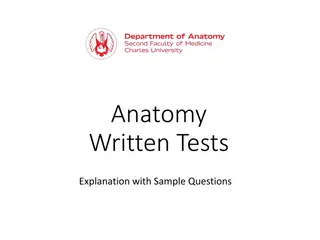Lecture series Gastrointestinal tract
Professor Shraddha Singh from the Department of Physiology at KGMU in Lucknow presents a comprehensive lecture series on the gastrointestinal tract.
9 views • 29 slides
Adaptasi Fisiologi Sistem Urinari dan Gastrointestinal pada Kehamilan
Proses adaptasi fisik, anatomis, dan fisiologis ibu hamil terhadap perubahan selama kehamilan dijelaskan. Adaptasi sistem urinari termasuk efek progesteron, peningkatan LFG, dan aliran plasma ginjal. Adaptasi sistem gastrointestinal melibatkan perubahan pada sistem pencernaan. Popular
14 views • 8 slides
Top-Gastrointestinal-Treatment-Centers-in-New-York
Navigating the complexities of gastrointestinal health can be overwhelming, especially in a bustling city like New York. With a plethora of healthcare options, finding the right gastrointestinal treatment center can be a daunting task. This guide aims to provide an overview of top-rated facilities i
0 views • 6 slides
Essential Overview of Gastrointestinal Physiology
Exploring the organization and general principles of gastrointestinal physiology, this content covers the anatomical and functional aspects of the GI system, including smooth muscle characteristics, neural control, blood flow, nutrient absorption, waste excretion, and regulatory functions like immun
0 views • 46 slides
Understanding Digestion and Absorption in the Gastrointestinal Tract
Digestion and absorption in the gastrointestinal tract are crucial processes for breaking down carbohydrates, fats, and proteins into smaller compounds that can be absorbed by the body. Carbohydrates undergo hydrolysis to convert into monosaccharides, fats are broken down from triglycerides, and pro
1 views • 22 slides
Detailed Anatomy Review for GIT Blood Supply
This content provides a thorough anatomy revision focusing on the blood supply of the gastrointestinal tract (GIT). It covers stations discussing the blood supply of the stomach, complications during cholecystectomy, perforated duodenal ulcer scenarios, pancreatic tumors, and structures related to m
0 views • 15 slides
Understanding Normal Flora of the Gastrointestinal Tract & Infectious Diarrhea
Normal flora in the gastrointestinal tract play a crucial role in maintaining health, but can also cause disease in certain conditions. This lecture covers the common flora in the GIT, their role in diseases, various types of acute diarrheal illnesses, epidemiology, and management of bacterial agent
1 views • 26 slides
Economic Aspects of Applied Plant Anatomy in Practical Use
Applied Plant Anatomy involves the practical application of anatomical knowledge in various fields such as identification, classification, taxonomic applications, medicinal plants, food safety, wood analysis, forensic investigations, and more. By understanding plant anatomy, professionals can utiliz
0 views • 26 slides
Understanding Anatomy: Branches and Components of the Human Body
Anatomy, the study of body tissue structures, encompasses various branches including Gross Anatomy, Systematic Anatomy, and Microscopic Anatomy. Osteology focuses on the skeleton's components and functions as a crucial support system for the body, aiding in movement and protection of organs.
5 views • 12 slides
Overview of the Gastrointestinal System and Its Functions
The alimentary tract supplies the body with water, electrolytes, and nutrients through processes like movement of food, digestion, absorption, and circulation. The gastrointestinal tract, starting from the mouth to the anus, is aided by accessory organs for digestion. Functions include motility, sec
0 views • 29 slides
Understanding the Normal Microbial Flora of the Human Body
The normal microbial flora, also known as the indigenous microbiota, inhabit various areas of the human body such as the gastrointestinal tract, respiratory tract, genitourinary tract, and skin. They play a crucial role in maintaining health and can re-establish themselves when disturbed. While resi
0 views • 22 slides
Comprehensive Overview of Gastrointestinal Tract Diseases
This detailed guide covers various gastrointestinal tract diseases caused by protozoa and helminths, including amebiasis, giardiasis, pinworm infestation, and trichinosis. It discusses their causes, symptoms, transmission, treatment, and prevention methods. The content provides insights into the lif
0 views • 9 slides
Understanding the Normal Flora of the Gastrointestinal Tract and Infectious Diarrhea
Explore the common normal flora of the gastrointestinal tract (GIT) and how they play a role in health and disease, specifically focusing on infectious diarrhea. Learn about different types of acute diarrheal illnesses, epidemiology, host defenses against GI infections, and the pathogenesis of bacte
0 views • 38 slides
Sexual and Reproductive Anatomy Lesson for 5th Grade
Explore the essential aspects of male and female sexual and reproductive anatomy in this detailed 5th-grade lesson from the Rights, Respect, Responsibility sexuality education curriculum. The images provided offer a visual guide to understanding external female anatomy and reproductive anatomy, aidi
0 views • 5 slides
Helicobacter Pylori: Characteristics, Pathogenesis, and Diagnosis
Helicobacter pylori is a spiral-shaped Gram-negative bacterium associated with various gastrointestinal conditions like gastritis, duodenal ulcers, gastric ulcers, and gastric carcinoma. It exhibits unique characteristics in common with Campylobacters and has specific culture and growth requirements
0 views • 5 slides
Preventing Healthcare-associated Gastrointestinal Infections
Learn about the types of microorganisms that cause gastrointestinal infections in healthcare settings, understand the risk factors, and discover methods for prevention. Key points include isolation, contact precautions, decontamination, antibiotic stewardship, hand hygiene, and food production contr
0 views • 39 slides
Global Gastrointestinal Stent Market
The Global Gastrointestinal Stent Market is expected to reach USD 0.75 Billion by 2032, at a CAGR of 4.8% during the forecast period 2022 to 2032.\n\n
1 views • 5 slides
Strategies and Lessons Learned for Moving Anatomy Labs Online
Explore strategies, challenges, and tips for transitioning large lab-based anatomy classes online. Discuss considerations, effective delivery options, assessment methods, and examples like Human Anatomy activities. Learn from an Associate Professor's experience teaching human anatomy and physiology
0 views • 13 slides
Understanding Gastrointestinal Motility: Key Concepts and Mechanisms
Gastrointestinal motility involves various processes like peristalsis, segmentation, basic electrical activity, and the migrating motor complex. Peristalsis is the reflex response to gut wall stretching, while segmentation helps mix intestinal contents and digestive juices. Basic Electrical Rhythm (
0 views • 19 slides
Anatomy of GI Rectum and Anal Canal: A Detailed Visual Guide
This visual guide showcases detailed images of the gastrointestinal (GI) rectum and anal canal anatomy, including structures such as the perineum, pelvic diaphragm, external and internal anal sphincters, and various junctions within the rectum. Each image provides a clear depiction of the anatomical
0 views • 6 slides
Understanding the Secretions of the Gastrointestinal Tract (GIT)
The gastrointestinal tract (GIT) is responsible for digestion, absorption, and secretion through various glands along the alimentary canal. Secretions are stimulated by factors like direct contact, nervous system activation, and hormonal regulation. Hormones released in response to food presence hel
0 views • 7 slides
Clinical Examination of Gastrointestinal Tract in Ruminants - Summary and Observations
Detailed examination of the gastrointestinal tract (GIT) in ruminants is crucial for diagnosing various diseases. Dr. Ranveer Kumar Sinha, an Assistant Professor cum Junior Scientist at Bihar Veterinary College, provides insights into the clinical examination, anatomy, history, and observations rela
0 views • 29 slides
Understanding Gastrointestinal Disease in Rabbits: A Comprehensive Overview
Gastrointestinal diseases are common in pet rabbits and can lead to serious health issues. Factors such as decreased motility, bloat, obstruction, and diarrhea affect their digestion. Understanding the complexities of rabbit physiology, nutritional requirements, and signs of GI disease is crucial fo
0 views • 15 slides
Understanding the Structure and Movement of the Gastrointestinal Tract
The gastrointestinal tract (GIT) comprises four layers - Mucosa, Submucosa, Muscularis externa, and Serosa. Each layer plays a crucial role in the digestion process. The GIT undergoes gut motility, including propulsive movements like peristalsis and mixing movements, to facilitate the movement of fo
0 views • 25 slides
Chemotherapy Utilization in End-Stage Gastrointestinal Cancer Patients
This presentation explores the prevalence, correlates, and outcomes of chemotherapy use in patients with end-stage gastrointestinal cancers. Data is presented on the frequency of chemotherapy administration, correlates, harms, and benefits in patients in their final months of life. Insights from stu
0 views • 21 slides
Study Guide: Gastrointestinal Tract & Liver Module for Second Year MBBS Students
Comprehensive study guide for second-year MBBS students at Avicenna Medical College covering the Gastrointestinal Tract & Liver Module. The guide includes information on learning methodologies, assessment methods, modular examinations, curriculum framework, and integrated teaching approaches. It pro
0 views • 24 slides
Comprehensive Overview of Medical Terminology in Gastrointestinal System
This content provides a detailed exploration of medical terminology related to the gastrointestinal system. It covers definitions, word roots, combining vowels, suffixes, and prefixes commonly used in this medical field. The material includes information on anatomical terms such as anus, appendix, c
0 views • 18 slides
Overview of Gastrointestinal Secretions and Structural Considerations
In this informative presentation by Assistant Professor Dr. Emre Hamurtekin, the focus is on gastrointestinal secretions including salivary, gastric, pancreatic, biliary, and intestinal fluids. Structural considerations such as the surface area for absorption, sphincters, villi, and crypts are discu
0 views • 33 slides
Understanding Gastrointestinal Agents: Acidifying Agents, Antacids, Saline Cathartics
Gastrointestinal agents such as acidifying agents, antacids, and saline cathartics are used to manage gastrointestinal disturbances. Acidifying agents like Hydrochloric Acid aid in gastric digestion, while antacids help reduce gastric acidity. Saline cathartics are used as laxatives. Achlorhydria, a
0 views • 36 slides
Equine Gastrointestinal Tract Disorders and Dysphagia Overview
This informative content covers various diseases of the gastrointestinal tract in horses, including oral cavity conditions, dysphagia, sialadenitis, and esophageal disorders like choke. It discusses anatomical classifications, causes, clinical manifestations, and treatment approaches for these condi
0 views • 19 slides
Understanding Gastrointestinal Agents and Disorders
Learn about gastrointestinal agents used in the treatment of GIT disorders such as achlorhydria, hyperacidity, diarrhea, and constipation. Explore the classification of gastrointestinal agents including gastric acidifiers, antacids, protectives, adsorbents, and cathartics. Discover the causes and sy
0 views • 45 slides
Comprehensive Guide to Cardiovascular Imaging and Anatomy
Explore a detailed collection of images showcasing cardiovascular imaging, radiological anatomy of the chest, vascular anatomy, and pulmonary conditions like embolism. Discover the gold standard for diagnosing pulmonary embolism, as well as CT angiograms and aortic arch anatomy. Engage with visuals
0 views • 59 slides
Diagnostic Methods for Gastrointestinal Diseases: A Comprehensive Overview
Explore various diagnostic methods for gastrointestinal diseases, including laboratory investigations, abdominal ultrasound features, and radiology techniques. Learn about the significance of different tests such as ESR, blood count, liver tests, and abdominal ultrasound in diagnosing conditions aff
0 views • 40 slides
Understanding and Managing Gastrointestinal Issues When Traveling
Explore insights on gastrointestinal concerns while traveling, including Delhi Belly, acute and chronic diarrhea, bacterial infections, prevention strategies, and treatment options like ORS, probiotics, and vaccines.
0 views • 11 slides
Understanding Stoma Care in Gastrointestinal Nursing
Stoma nursing care involves managing an incised opening for drainage or other purposes, such as colostomy or ileostomy. It focuses on patient independence and freedom post-discharge. The gastrointestinal tract plays a crucial role in food transport and waste elimination. Different types of stomas, s
0 views • 17 slides
Understanding Gastrointestinal Function and Its Regulation by Drugs
The gastrointestinal tract, a muscular tube from the mouth to the anus, is influenced by drugs affecting its function. Structures vary in different animals, with control by the autonomic nervous system branches. Parasympathetic stimulation increases motility, while sympathetic stimulation decreases
0 views • 36 slides
Introduction to Anatomy: Anatomical Terms and Skeletal System
An introduction to anatomy covering anatomical terms and the skeletal system. It defines anatomy, explains anatomical sciences, discusses the skeletal system, and outlines anatomical terminology including terms of position. The content includes objectives, classifications of bones, and different ana
0 views • 28 slides
Gastrointestinal Conditions Management Guidelines 2018
This presentation covers guidelines for managing gastrointestinal conditions, including dyspepsia, heartburn, indigestion, and helminthic infestations. It provides recommendations on medications such as Lansoprazole for short-term therapy and Albendazole as an alternative for roundworm infestations.
0 views • 5 slides
Essential Monitoring and Care for Gastrointestinal Patients
Learn about monitoring and caring for gastrointestinal patients, including identifying key symptoms like appetite changes, taste alterations, swallowing difficulties, gastric dyspepsia, and more. Discover how to provide proper nursing care, address acute abdominal pain and gastrointestinal bleeding,
0 views • 28 slides
Anatomy Written Tests Overview with Sample Questions
Explore different types of anatomy questions commonly seen in written tests, including general anatomy, structural anatomy, functional anatomy, topographical anatomy, imaging anatomy, clinical anatomy, microscopic anatomy, and embryo-related topics. Sample questions and answers are provided for each
0 views • 12 slides







































